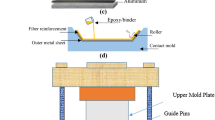Abstract
NASA Lewis Research Center is presently involved in developing structurally reliable metal and ceramic matrix composites for application in advanced gas turbine engines. This paper examines the general property requirements for the high performance fibers of these composites. Also presented are examples of how these fiber property guidelines are influencing current fiber improvement and evaluation studies, with specific emphasis on commercially available boron and SiC fibers.
Similar content being viewed by others
References
K.M. Prewo, “The Importance of Fibres in Achieving Impact Tolerant Composites,” Phil. Trans. R. Soc. Lond. Ser. A 294, (1980), pp. 551–558.
D.L. McDaniels and R.A. Signorelli, “Improved Impact-Resistant B/Al Composites for Use as Turbine Engine Fan Blades,” Failure Modes in Composites, III, The Metallurgical Society of AIME, New York, 1976, pp. 27–57.
J. Aveston, G.A. Cooper and A. Kelly, “Single and Multiple Fracture,” The Properties of Fibre Composites, Science and Technology Press, England, 1971, pp. 15–24.
R.A.J. Sambell, A. Briggs, D.C. Phillips, and D.H. Bowen, “Carbon Fibre Composites with Ceramic and Glass Matrices; Part 2, Continuous Fibres,” J. Mater. Sci. 7 (1972), pp. 676–681.
R.W. Rice, “Mechanisms of Toughening in Ceramic Matrix Composites,” Ceram. Eng. Sci. Proc. 2 (1981), pp. 661–701.
J.A. DiCarlo and R.J. Smith, “Strength Advantages of Chemically Polished Boron Fibers,” NASA TM-82806 (1982).
S. Yajima, “Special Heat-Resisting Materials from Organometallic Polymers,” Am. Ceram. Soc. Bull., 62 (1983). pp. 893–903.
T. Mah, N.L. Hecht, D.E. McCullum, J.R. Hoenigman, H.M. Kim, A.P. Katz and H.A. Lipsitt, “Thermal Stability of SiC Fibers (Nicalon),” J. Mater. Sci. 19 (1984), pp. 1191–1201.
C.H. Andersson and R. Warren, “Silicon Carbide Fibres and Their Potential for Use in Composite Materials, Part I,” Composites, 15 (1984), pp. 16–24.
J.A. DiCarlo and W. Williams, “Dynamic Modulus and Damping of Boron, Silicon Carbide, and Alumina Fibers,” Ceram. Eng. Sci, Proc., 1 (1980), pp. 671–692.
R.T. Bhatt, “Environmental Effects on the Tensile Strength of Chemically Vapor Deposited (CVD) Silicon Carbide Fibers,” to be published.
J.A. DiCarlo, “Creep of Chemically Vapor Deposited SiC Fibers,” to be published in J. Materials Science.
J.A. Cornie, R.J. Suplinskas, and H. Debolt, “Surface Enhancement of Silcon Carbide Filament for Metal Matrix Composites,” ONR Contract N00014-79-C-0691, (1981).
F.W. Wawner, A.Y. Teng and S.R. Nutt, “Microstructural Characterization of SiC (SCS) Filaments,” SAMPE Q. 14 (1983), pp. 39–45.
G. Simon and A.R. Bunsell, “The Creep of Silicon Carbide Fibers,” J. Mater. Sci. Lett. 2 (1983), pp. 80–82.
G. Grathwohl and F. Thummler, “Creep of Reaction Bonded Silicon Nitride,” J. Mater. Sci. 13 (1978), pp. 1177–1186.
Additional information
James A. DICarlo received his Ph.D. in condensed matter physics at the University of Pittsburgh in 1964. He is currently a Research Scientist in the Ceramics Systems Branch at NASA Lewis Research Center in Cleveland, Ohio.
Rights and permissions
About this article
Cite this article
DiCarlo, J.A. Fibers for Structurally Reliable Metal and Ceramic Composites. JOM 37, 44–49 (1985). https://doi.org/10.1007/BF03257712
Published:
Issue Date:
DOI: https://doi.org/10.1007/BF03257712




